1lumen selects and reviews products personally. We may earn affiliate commissions through our links, which help support our testing.
Gift Glow EDC Dawn titanium review
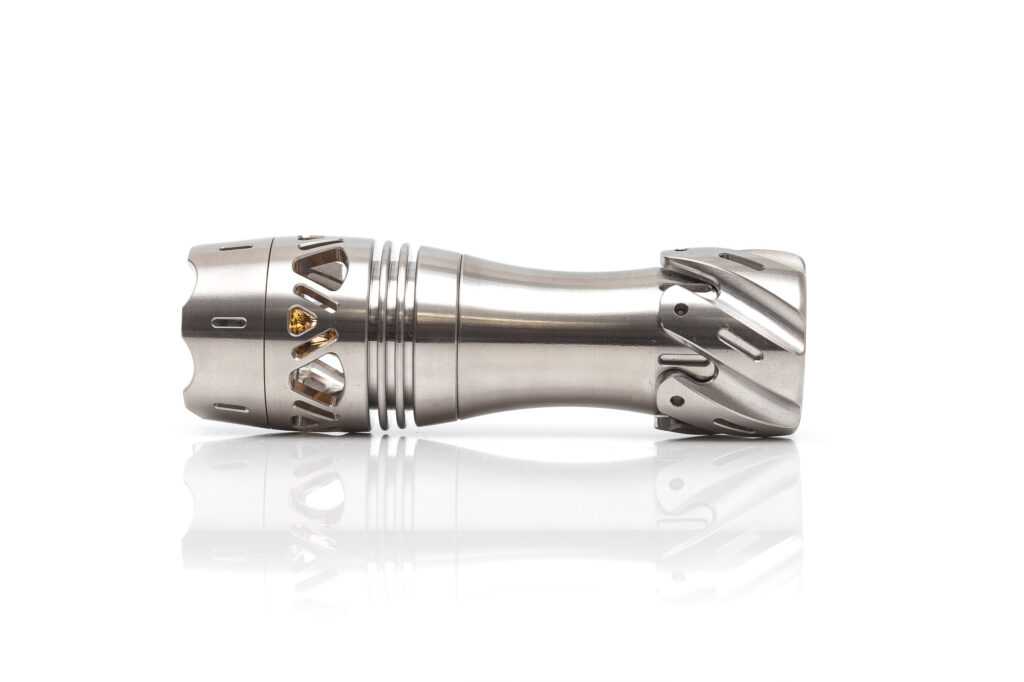
Gift Glow EDC Dawn Titanium specifications
| Brand/model | Gift Glow EDC Dawn Titanium |
|---|---|
| LED | Nichia 219C 4000K |
| Max. Lumens | 1,100 lm |
| Max. Beam intensity / distance | ? |
| Battery config. | 1*16340 |
| Onboard charging | N/A |
| Modes | 2 + AUX |
| Blinkies | Flash strobe |
| Reflector | TIR |
| Waterproof | ? |
| Review publication date | August 2022 |
Introduction:
Many people start their flashlight journey with something cheap and ‘bright’. But once they are into flashlights for some time, they might notice a particular niche within the world of flashlights, called the exotic metal (read expensive) lovers. I just made that word up.
These type of folks collect higher-priced custom made lights, often made of exotic metals, costing thousands of dollars. I’m talking about metals like Zirconium, Damasucus, Mokume, and Trimascus etc.
Most people don’t want to spend that much money on a flashlight. But there are also flashlights costing a little more than aluminum flashlights. Those are the titanium flashlights built by well-known brands like Olight, Fenix, and Acebeam. They make limited runs of some of their most popular lights, without breaking the bank.
Then there is a small group of custom builders that fall in between the well-known brand titanium flashlights, and the high-end luxury flashlights. This review is about one of those. It’s the Gift Glow EDC Dawn Titanium. Although this name may sound unfamiliar, the person behind this name has designed flashlights for quite a few well-known brands.
This particular Dawen flashlight has a limited run of 100, if I understood correctly.
Package quality.
Most, if not all custom builders don’t pay too much attention to their packaging. The Dawn was shipped in a generic transparent case. Inside the case you can find the following:
- The flashlight: Gift Glow EDC Dawn Titanium (in vacuum sealed plastic bag)
- Piece of paper with the text: 4000K
There were no other accessories included. In the world of custom builders, this is not uncommon. If you have any trouble with the flashlight, you can contact the builder himself, and ask for help. This is totally different from the big brands. Just keep this in mind, if you ever want to get a custom light.
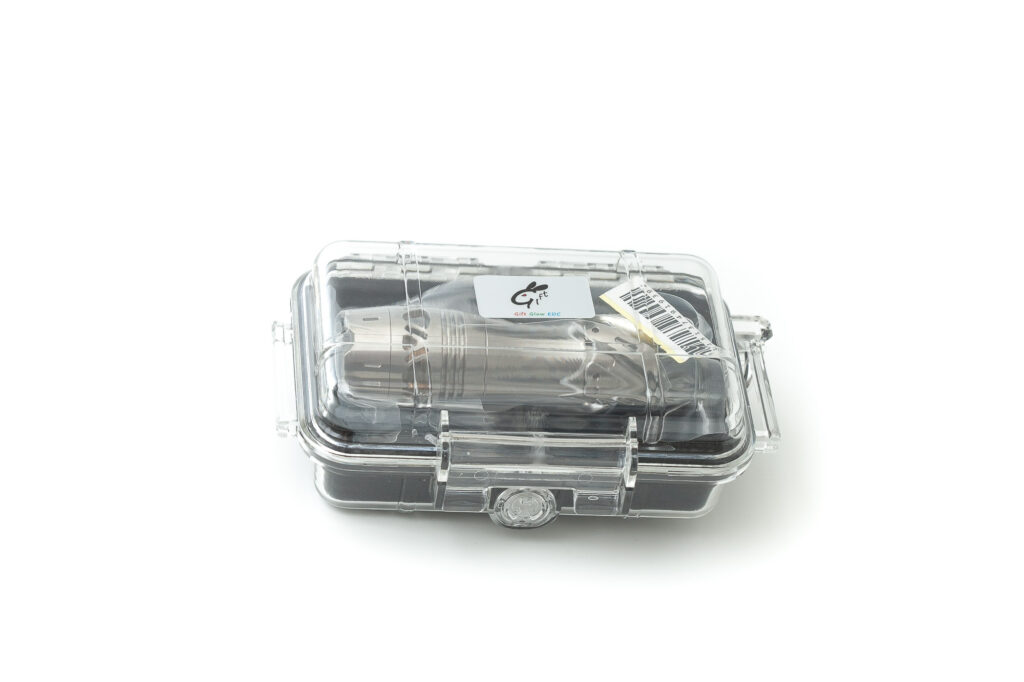
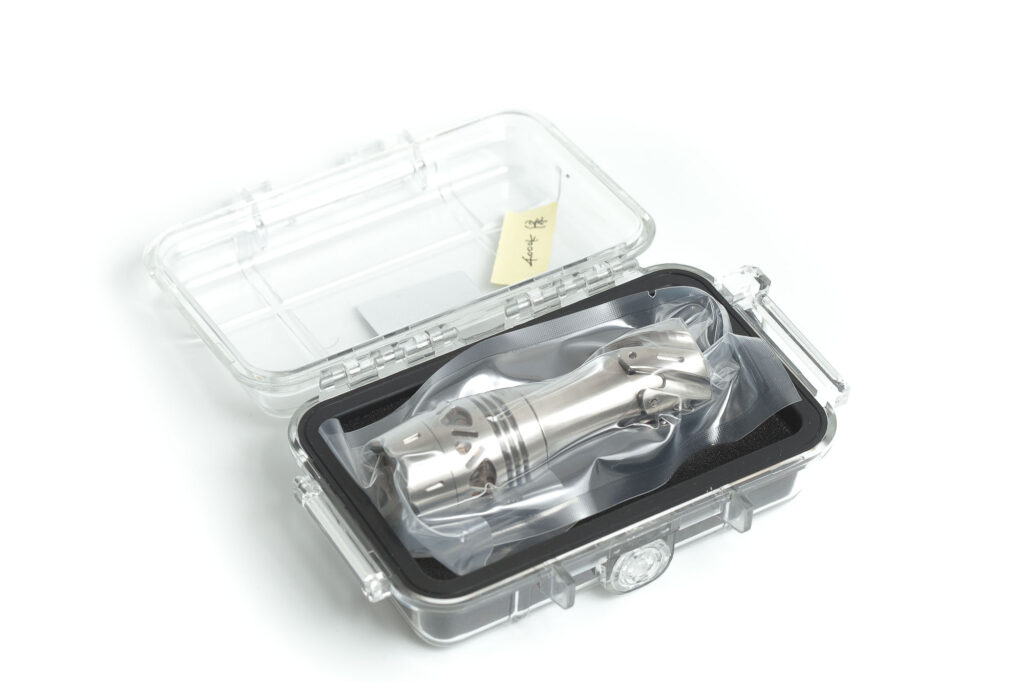
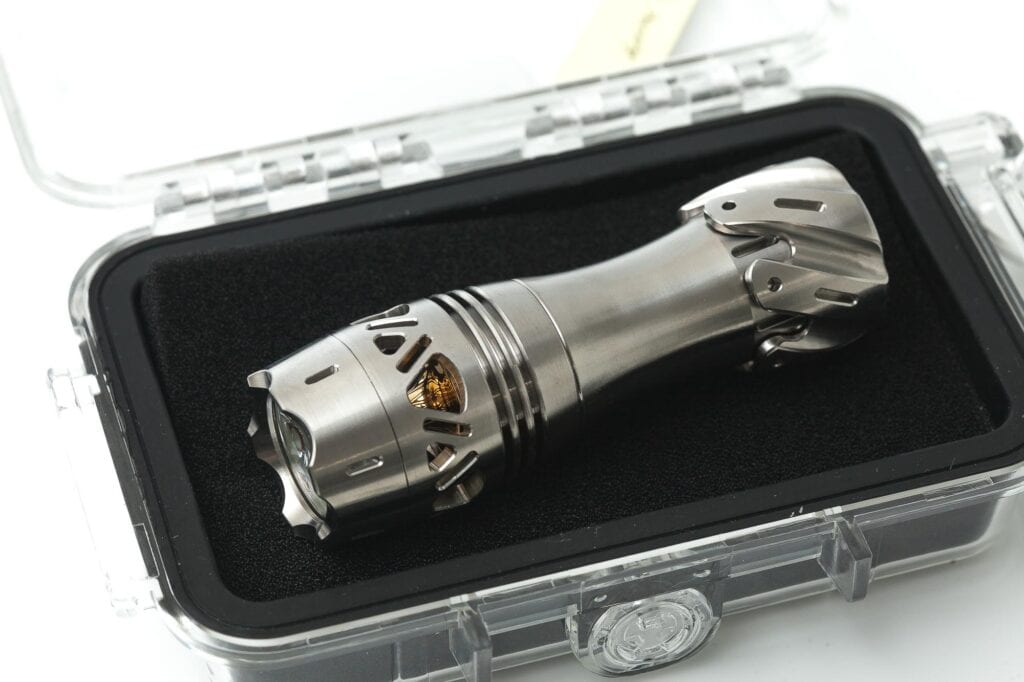
Flashlight in use
There are a few unique things to this flashlight. And one very obvious is the relatively strange looking rear-end. It’s actually a fidget spinner that rotates, so it can be used to reduce your stress. I’m not 100% sure how long this spinner would last if you carry it in your pocket! These kinds of flashlights are more men’s jewelry than anything else.
Another unique feature is the open head design. You can see through the head, with a polished gold-looking center column. The wires go through that center column to connect the MCPCB to the driver. Because of this design and the titanium build, you shouldn’t expect a high output. If you’re after a hotrod, go for an aluminum (or copper) flashlight, and not a titanium one.
You can add 6 trits to the head, 6 to the fidget spinner, and 6 behind the fidget spinner to make it look even more intriguing.
Even though I unscrewed the tailcap several times, the threads are still relatively smooth. But I know that this will only last for a short time, because titanium threads will become gritty eventually.
The switch is a forward clicky switch, and the UI isn’t the same as anything else out there! You wouldn’t understand it without actually seeing it in action, or reading my explanation below. Trust me!
And just like many exotic and custom-made titanium EDC flashlights, the battery type is a bit unusual. It’s using the unpopular 16340 type battery, which is the same size as a CR123 battery. And CR123 batteries work as well.
The only way I would recommend carrying it is inside a case. I wouldn’t carry it inside a pocket, collecting dirt and dust. It doesn’t even have a pocket clip to carry inside a pocket anyway.
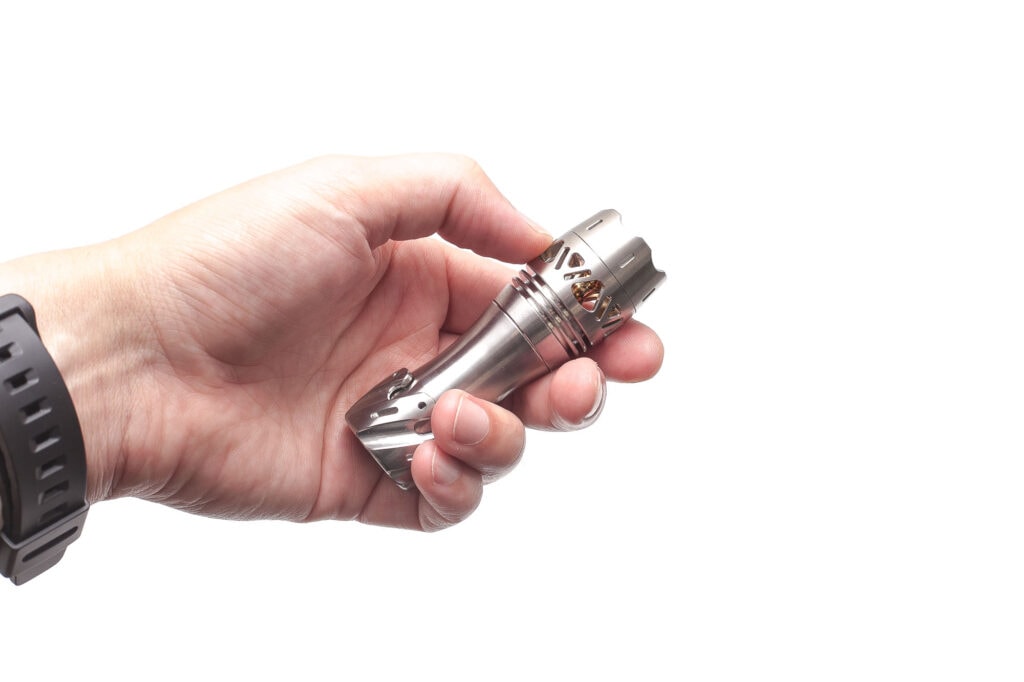
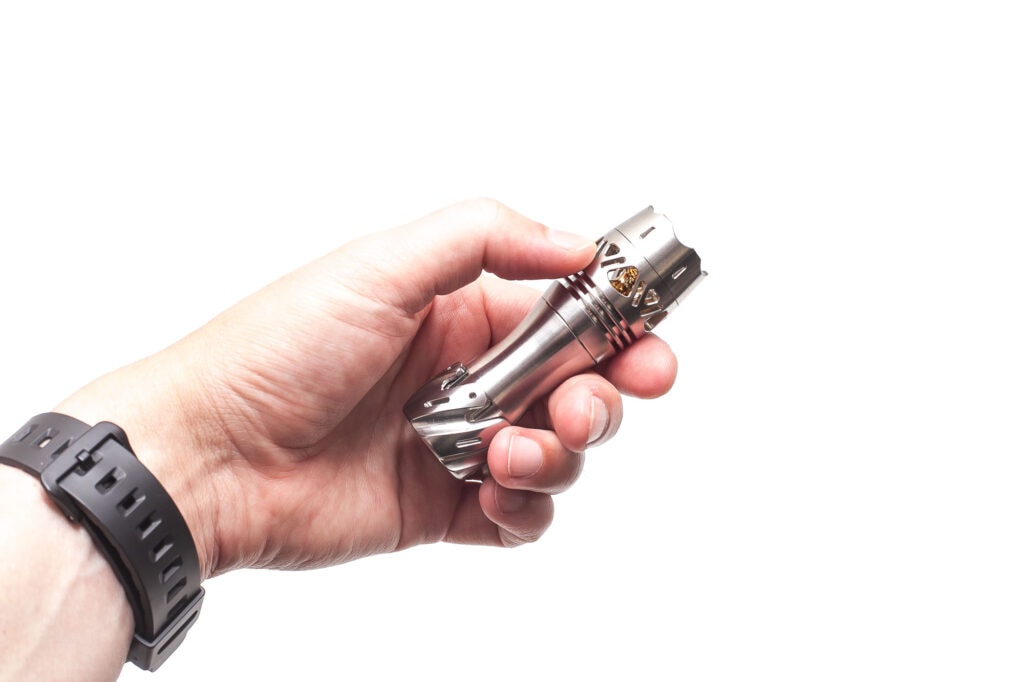
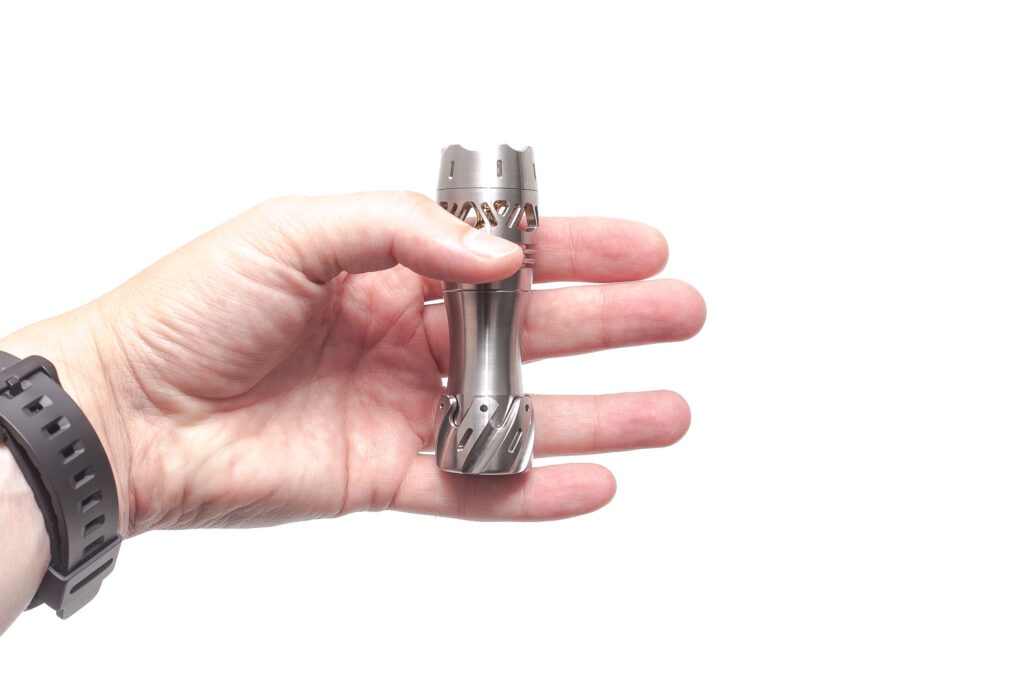
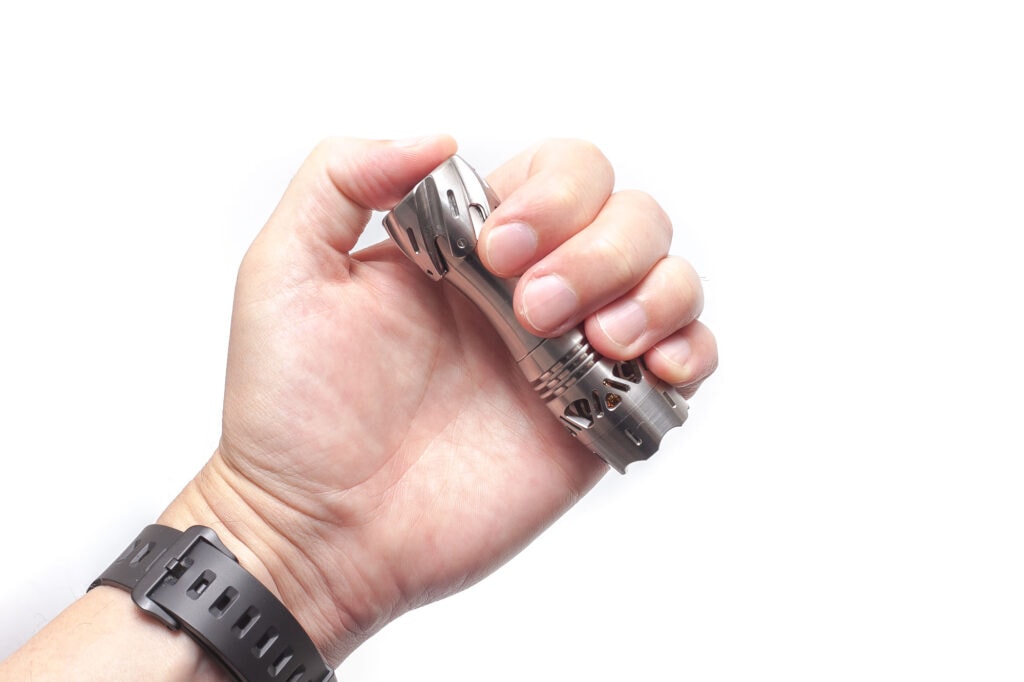
Build Quality, and Warranty
Titanium is stronger than aluminum, but it’s also heavier because of the higher density. And while some brands produce different colored titanium flashlights, their coating (anodization?) is much weaker than HAIII used on aluminum. So if you decide to anodize titanium, it will be weak.
The build quality seems to be superb. Everything seems to be chamfered and there are no real sharp edges. The bezel does feel a bit sharp, but not sharp enough to cut your fingers.
Warranty?
Just like other custom builders, reach out the builder if you need any help. The builder of this flashlight was kind enough to help me understand the UI, so I would expect the same kind of help if you have any issues.
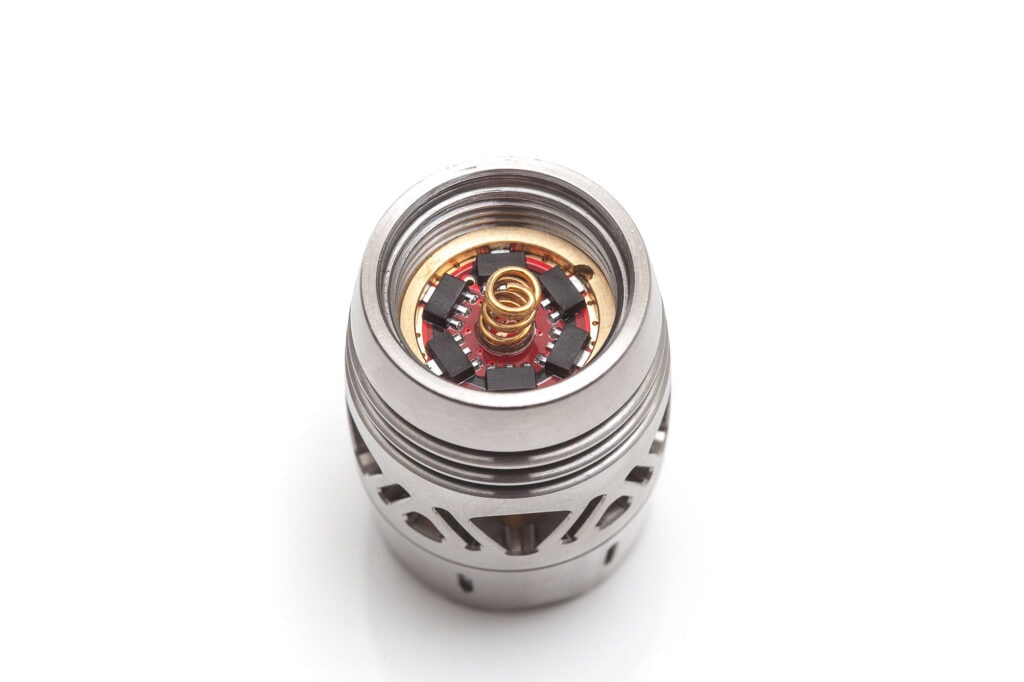
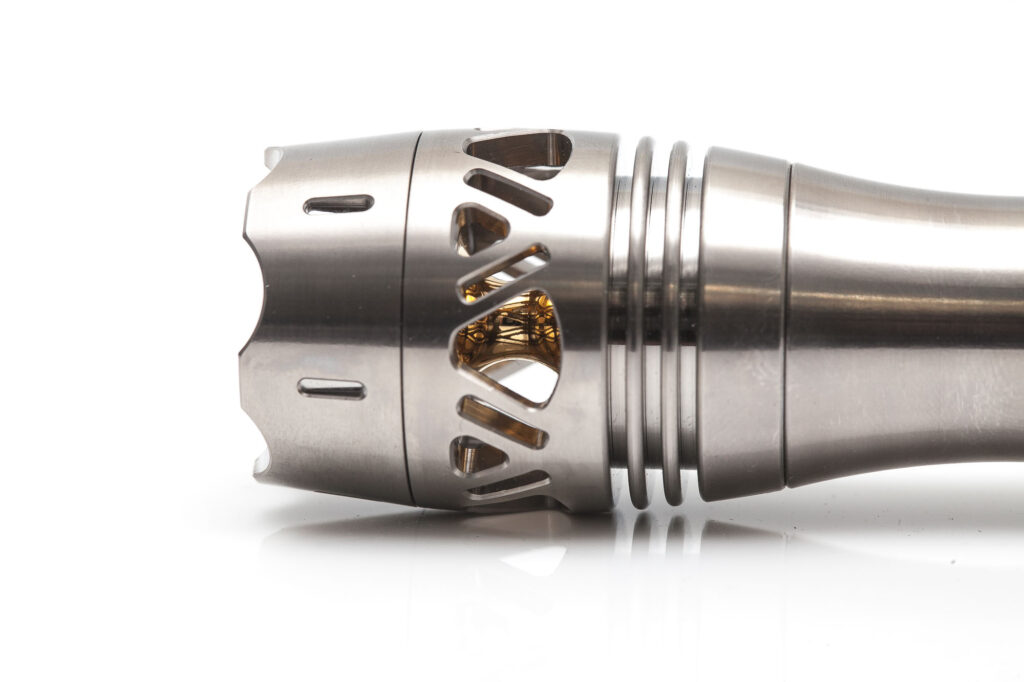
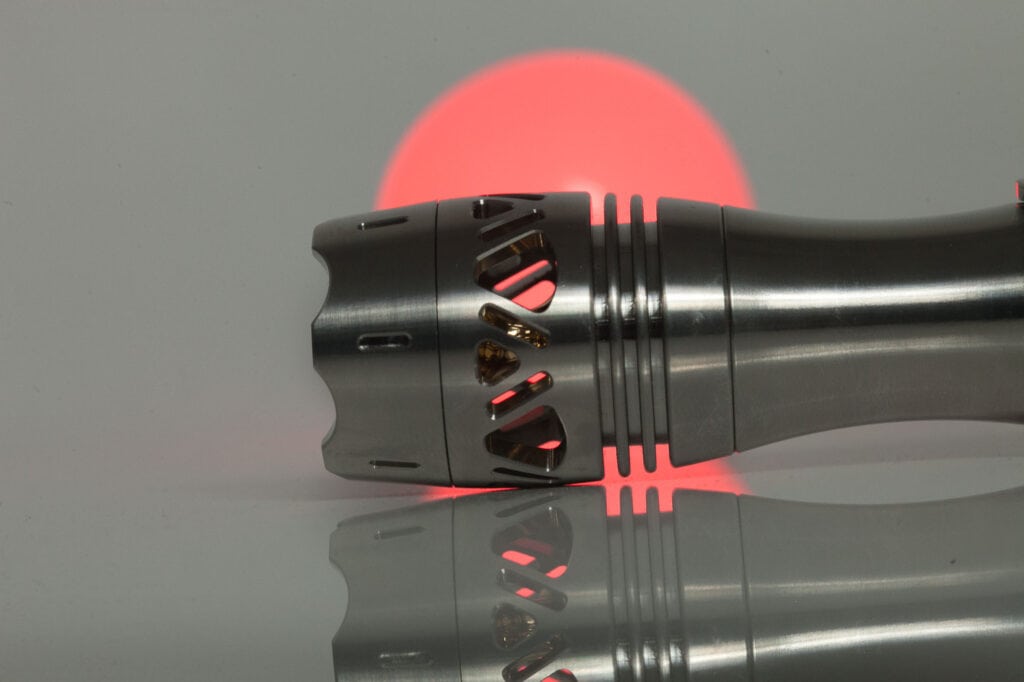
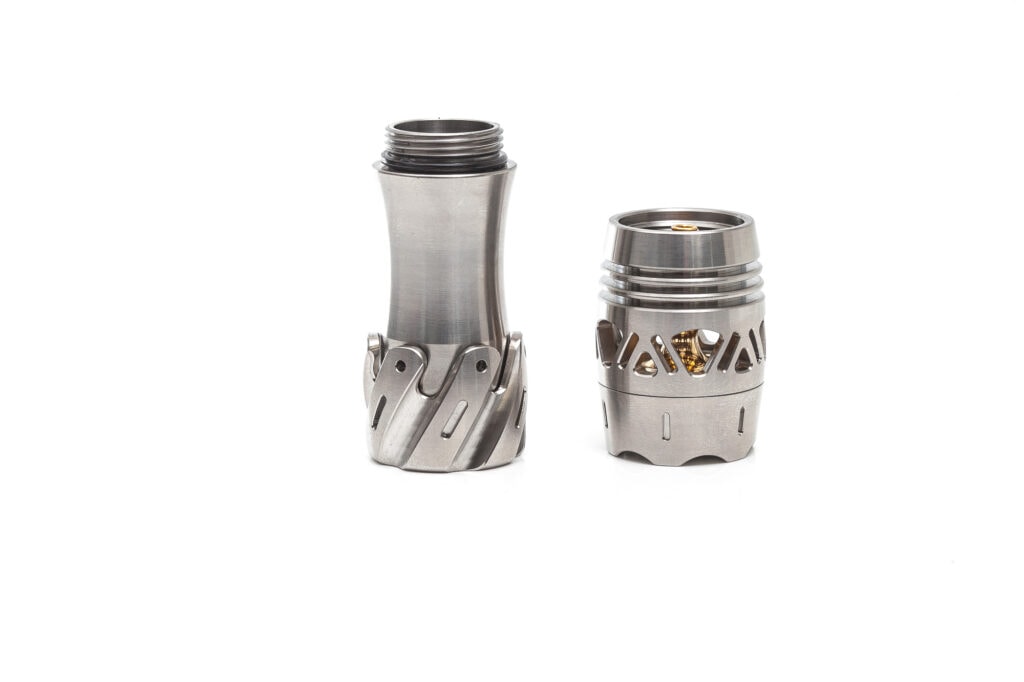
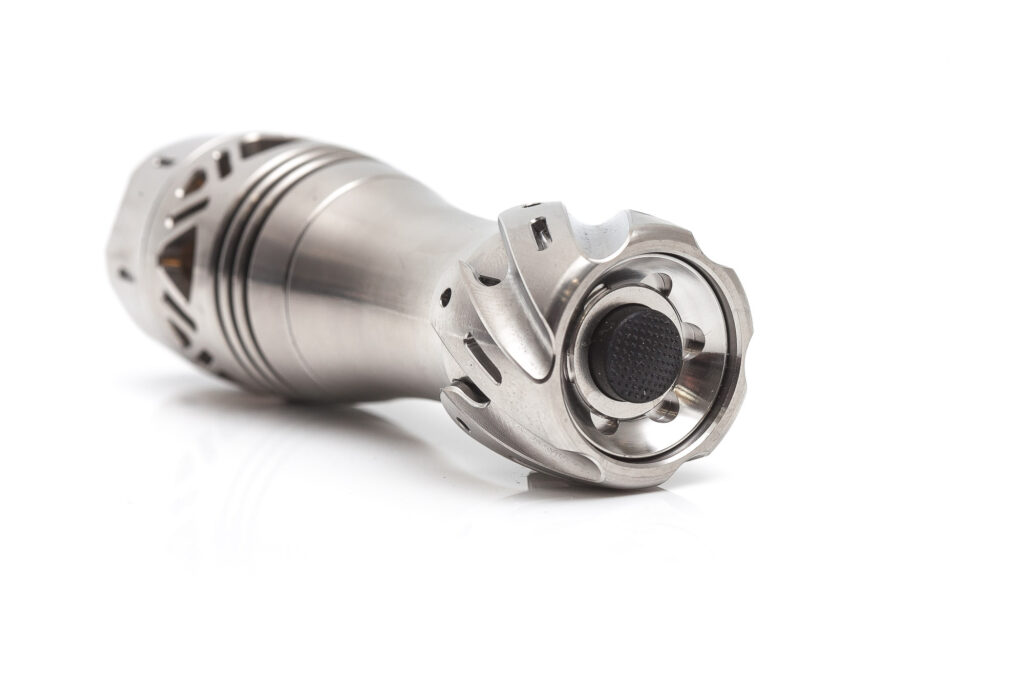
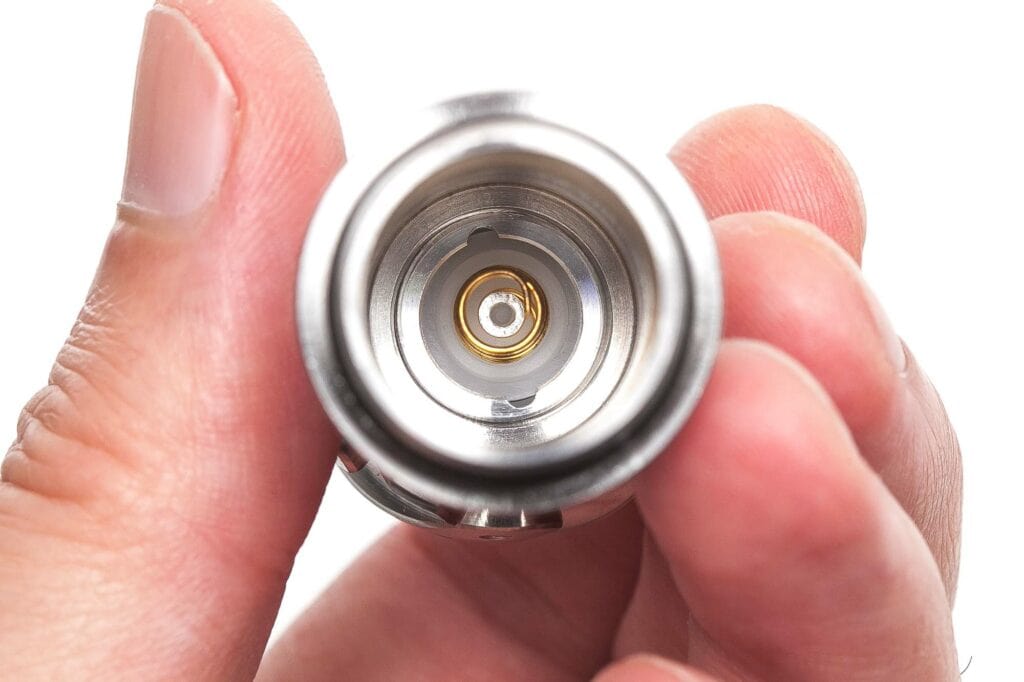
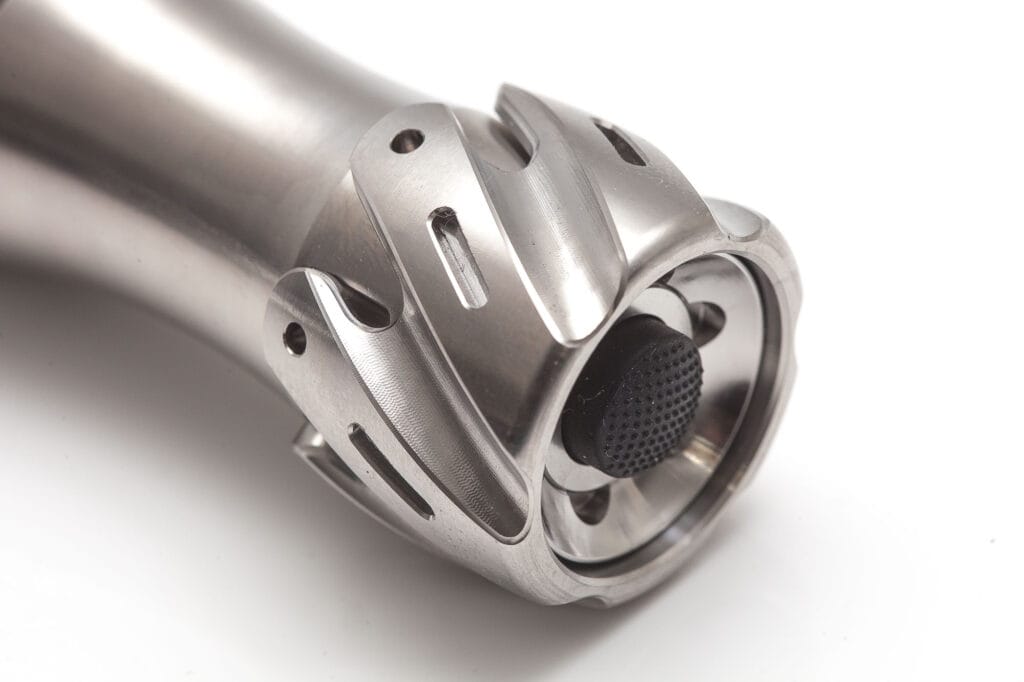
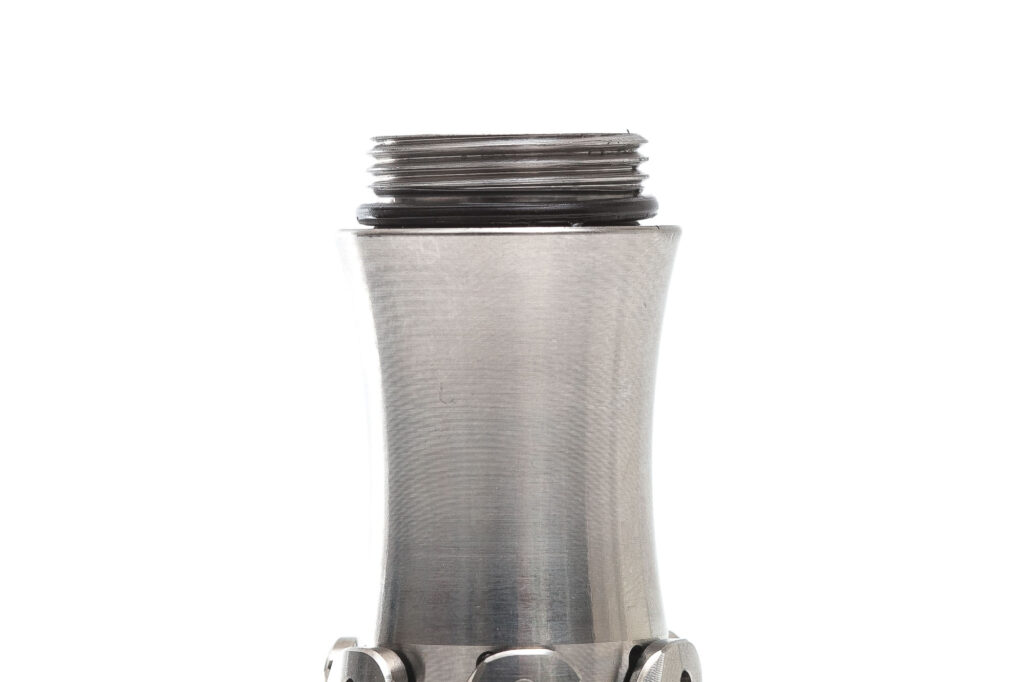
LED, Lens, Bezel, Beam, and Reflector
The description at Nealsgadgets mentions 2 color options Nichia 4000K and 5000K, without telling what specific Nichia it uses. But if you look through the TIR optics, you’ll notice the ‘flower shaped’ design of the Nichia 219C. So I assume both LED versions use Nichia 219C. The one I’m reviewing here is the 4000K version.
The 3 LEDs sit behind a TIR optic, that is protected by a crenelated bezel. There is also 1 AUX LED that is a bit hard to see. If I didn’t know that it has an AUX LED, I wouldn’t have seen it.
There seems to be a protective glass lens in front of the optic with AR coating.
The beam is pretty smooth with a hotspot and very smooth spill. It’s definitely a bit on the yellowish side.
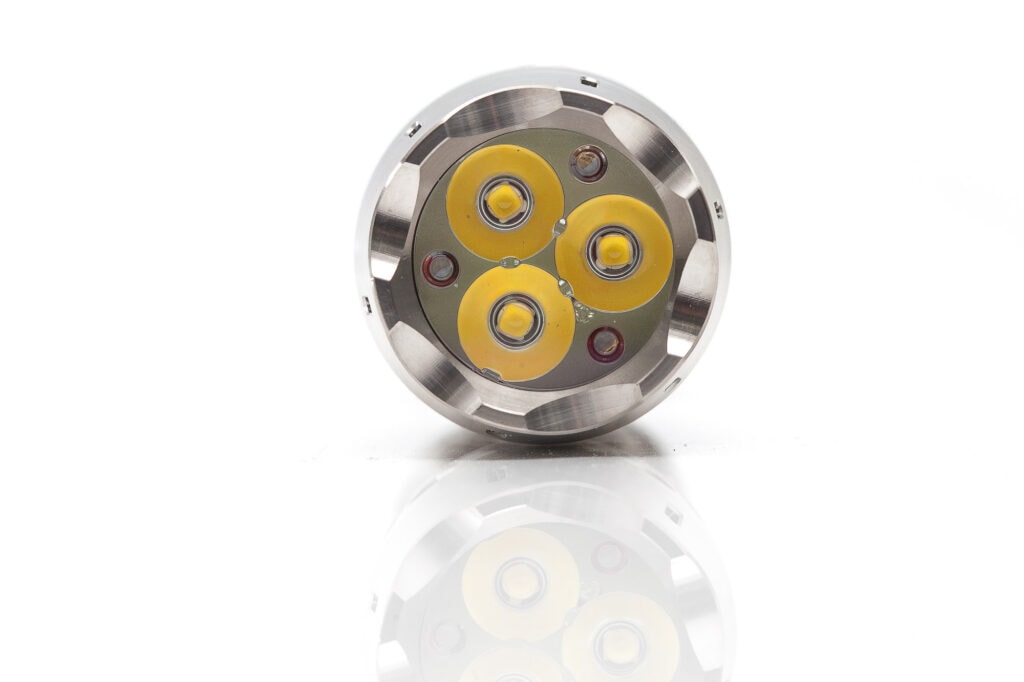
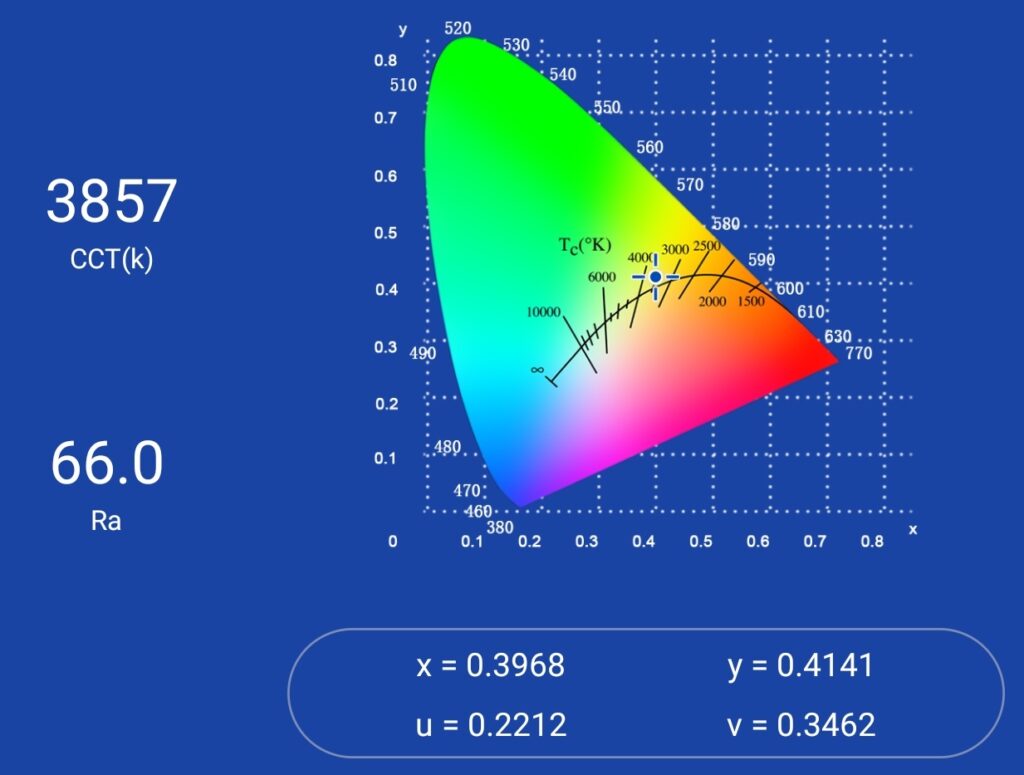
Dimensions and size comparison
Dimensions:
| Gift Glow EDC Dawn dimensions | Millimeters | Inches |
|---|---|---|
| Length | 92.4 mm | 3.64″ |
| Widest diameter | 29.8mm | 1.17″ |
| Widest spinning tailcap diameter | 28.8mm | 1.13″ |
Weight:
| Gift Glow EDC Dawn weight | Weight in grams | Weight in Oz. |
|---|---|---|
| Without battery: | 122.4 grams | 4.32 oz. |
| With Eag tac battery | 140.2 grams | 4.95 oz. |
Titanium Flashlight comparison
Size compared to other titanium flashlights
From left to right: Jetbeam E1 (16340), Jetbeam DM25 (18350), Baivic V4+ (18350), Reylight Krystal (18350), Sunwayman V10R Ti (16340), Reylight Dawn (18350).

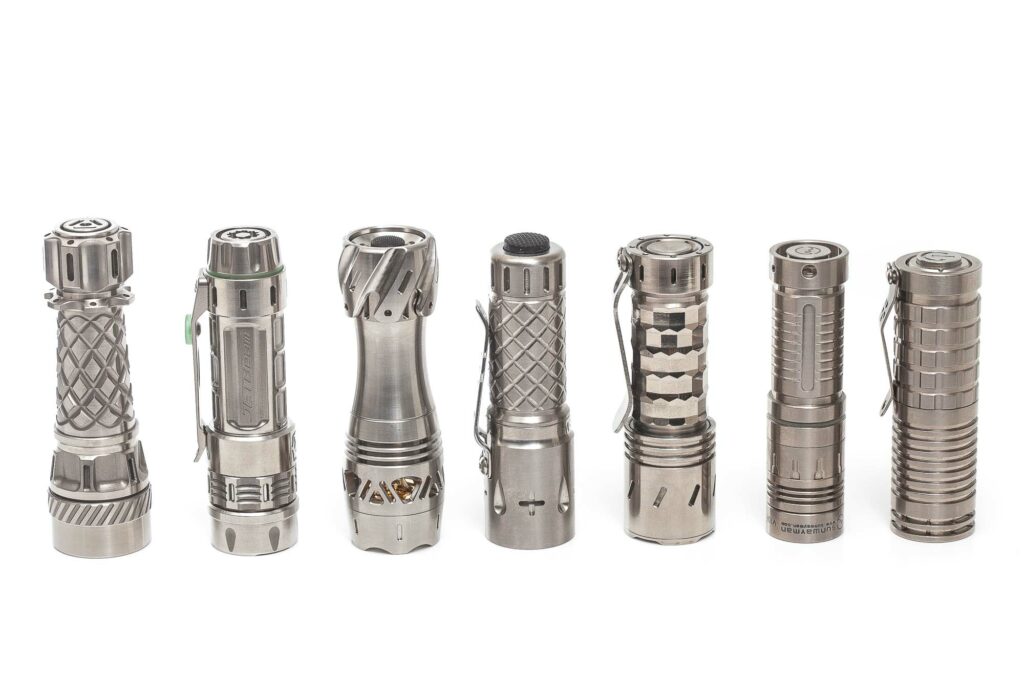
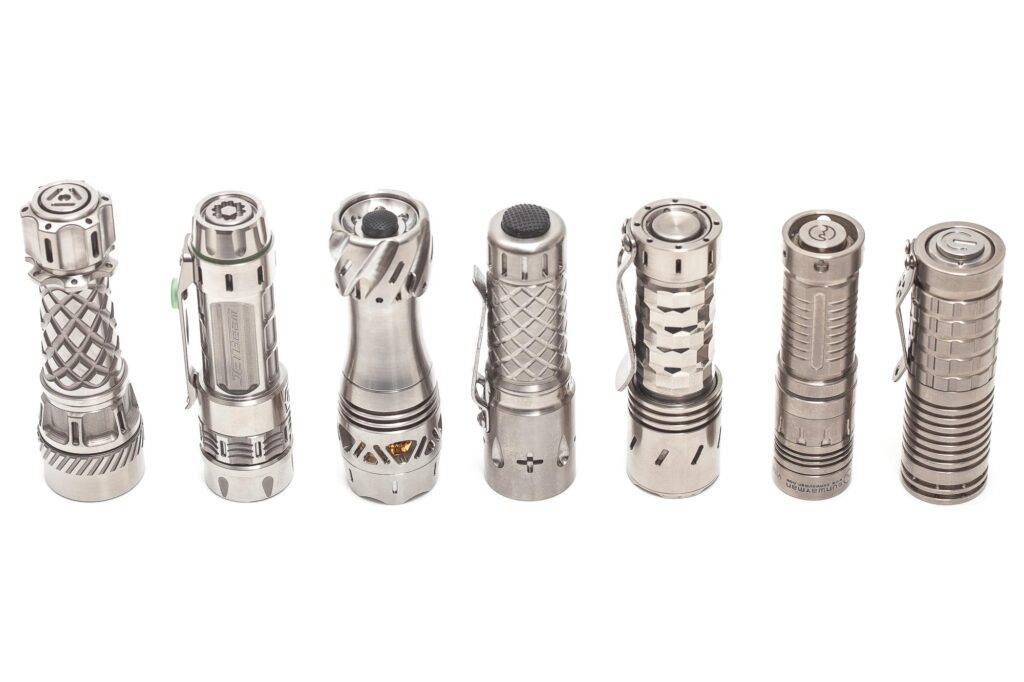
Driver & User Interface:
Beautiful flashlights have hard-to-understand UIs. At least that what I found out with some of the Titanium flashlights I reviewed, including the Jetbeam E2, and Bavic V4+. And the Gift Glow EDC Dawn is no exception. I had a really hard time figuring out how to get to all the modes. I encountered some sort of bike flash, and probably a battery level indicator. But I couldn’t access them consistently…
After clicking around for many times, I accidentally enter one of them, but never remembered what tap/click sequence i used to entering this mode.. Quite frustrating. It doesn’t work like anything I used before.
So, I reached out to Gift Glow EDC, and asked for some help. He then shared the following diagram.
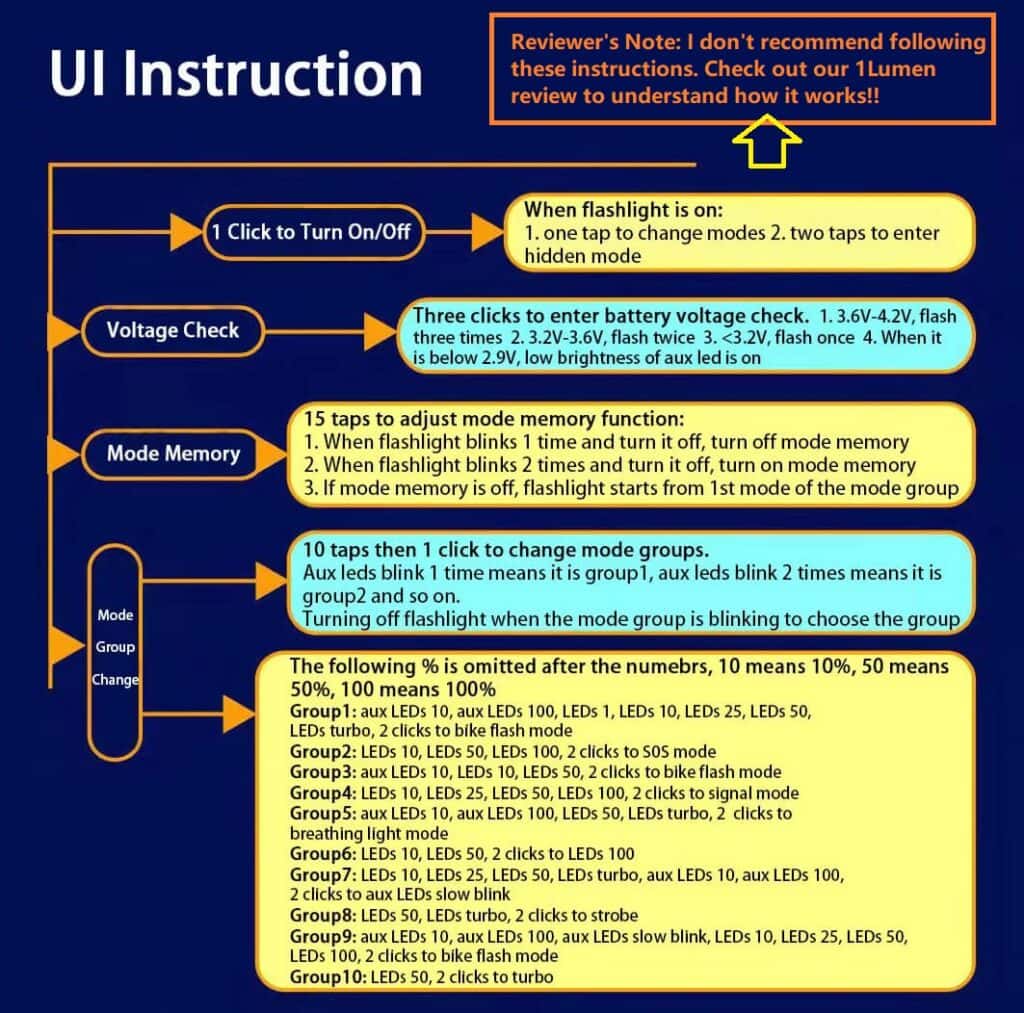
- Group 2 is incorrect in the above diagram.. I don’t want to test every group, but I hoped the maker could have spent the time to really go through the options.
- Also, Group 3 starts in AUX100 and not in AUX10
- Group 8 is 50 – 100 and not Turbo
I was happy at first, because I thought I could finally decipher how to use it. But that was pretty short lived. The switch is a forward-clicky switch but the explanation sounds like a reverse clicky switch menu. You can’t tap a forward-clicky switch when it is activated. But the explanation of the designer and some videos of how it should work, solved my problem. But the above diagram will throw you off. Please read the following UI explanation.
Available modes in different mode groups:
- All modes according to the UI instructions: AUX 10%, AUX 100%, LED 1%, LED 10%, LED 25%, LED 50%, LED 100%, LED Turbo.
Available blinky modes, in different mode groups:
- Bike Flash (AUX & LED), AUX slow blink, Strobe (LED), breathing (LED)
Default UI
(This is mode group 3)
From OFF:
- Half-press 1 time: AUX momentary
- Tapping slowly: change modes from AUX100% – LED 10% – LED 50%
- 3 fast taps: battery check
- Single-click: turn on in the selected mode
Extra info on default UI: (although the UI table shows AUX10%, that’s incorrect, it’s 100%)
From ON:
- Single-click: turn off
- There are no other options!
Mode memory:
- By default No memory. But this can be changed in a hidden menu.
- To turn mode memory on/of do the following: tap the switch 15 times slowly and keep the switch depressed at the 15th time
- Another and easier way is to tap 14 times slowly, and do a full click at the 15th press.
- The light will 2 sets of blinks:
- 1 blink = no memory
- 2 blinks = memory.
- If you don’t want mode memory, turn the light off after you see 1 blink
- If you want mode memory, turn the light off after you see 2 blinks (the 2 blinks come after the 1 blink, so just wait)
Blinky modes menu:
- We are still looking at the default mode group 3:
- Momentary: Tap 2 times and hold the switch half pressed the second tap
- Continuous: tap 1 time, followed by a full click.
Low battery warning:
- The light will turn into a AUX mode when the battery runs low
Lock-out mode:
- None. And no mechanical lockout is possible, because of the titanium, non-anodized threads.
PWM:
- Not visible by eye
Change mode groups? Menu programming / configuration mode
Do 10 slow taps, like you are counting slowly, and do a full click at the 11th press.
Note: The speed of tapping is very sensitive, so you should go slow. You should see your AUX light blinking 2 times, and then 3 times, and then 4 times. If you don’t see that, you accidentally turned on the hidden mode, or battery check.
The maker of the UI explained that it starts at group 2 on purpose.. So, if you want to activate mode group 1, you have to wait till after group 10.
| Group | Available modes: | Hidden |
|---|---|---|
| 1 | AUX10 – AUX100 – 1 – 10 – 25 – 50 – Turbo | Bike flash |
| 2 | 10 – 25 – 50 | SOS mode |
| 3 (Default) | AUX100 – 10 – 50 – 100 | Bike flash |
| 4 | 10 – 25 – 50 – 100 | Signal mode |
| 5 | AUX10 – AUX100 – 50 – Turbo | Breathing mode |
| 6 | 10 – 50 | 100% |
| 7 | 10 – 25 – 50 – Turbo – AUX10 – AUX100 | AUX slow blinking |
| 8 | 50 – 100 | Strobe |
| 9 | AUX10 – AUX100 – AUX slow blink – 10 – 25 – 50 – 100 | Bike flash |
| 10 | 50 | Turbo |
Note: the hidden mode is only available from OFF. You can do the following:
- 2 quick taps and hold at the second tap = momentary hidden mode
- 1 tap and quickly followed by a full click = continous hidden mode
Firmware / UI Conclusion:
The UI is hard to program, and most options are for a normal flashlight user not very useful. Even the so called 1% is still very bright.
My suggestions:
- Probably use a reverse clicky switch? But the problem with a reverse clicky, is that all programming modes have to be from the On position…. which maybe no problem, if you hide them well enough.
- Get rid of most of those hidden modes, or get to them with more taps (not 2).
- Use double tap only for Turbo (with a reverse clicky)
- If you want those blinkies, use a different number of taps, maybe 5?
- Low mode: Get a much lower low mode. Even now, the 1% is still too bright IMHO.
- Get more lower modes.. the 25, 50 and 100% look too close in person! Get something like 1 lumen, 10 lumen, 100 lumen.
- Finetune the tapping speed so they are similar to Biscotti or NarsilM.
- Get at least some of the basic menus found on other lights, like 4 modes (without the hidden blinkies) with some real lows
I like the mode memory option, although it’s a bit difficult to get to.
Here’s a quick video about the UI
Batteries & Charging
Fortunately enough, I bought a new 16340 not too long ago. It’s an Eagtac 16340 with 750mAh, and IC protection. It’s not a high drain battery, so that could be a problem for a high-power flashlight.
Fortunately, most titanium flashlights are not high-power, so I hope this is going to be just fine.
You can also use a CR123 battery.
Performance test
Lumen measurements:
All output numbers are relative to my homemade Integrating Sphere. It is set up with an Extech SDL400 Lux Meter for measurements including a Kenko PRO1D ND-16 filter. The base measurement is done with a Convoy S2+ that has been tested at 255 lumens.
All of my readings were taken from a fully-charged Eagtac 16340 battery with 750mAh.
The measurement at turn on and at 30 seconds were done manually. The 10 minutes measurements were taken from the runtime graph.
| Mode | at turn on | 30sec | 10 min |
|---|---|---|---|
| 1% | 32 lm | 32 lm | – |
| 10% | 162 lm | 161 lm | 159 lm |
| 25% | 315 lm | 313 lm | 306 lm |
| 50% | 591 lm | 588 lm | 567 lm |
| 100% | 968 lm | 957 lm | -* |
| Turbo* | 1234 lm | 584 lm | 580 lm |
*Turbo mode was tested with fan pointed at it for the runtime test.
- High mode was tested without a fan, and turned to AUX mode after 5 minutes.
Runtime: Battery life
The runtime test was done with the 50cm integrating sphere, including the Kenko Pro1D ND-16 filter and Extech SDL400 data logging Lux Meter.
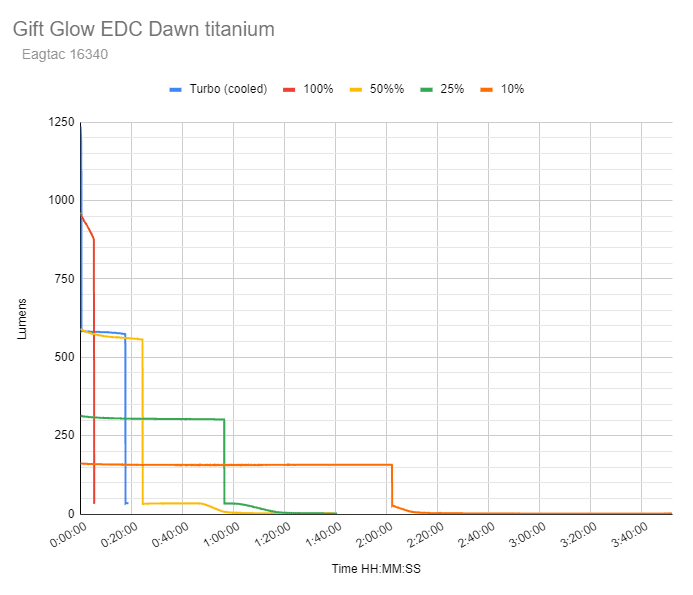
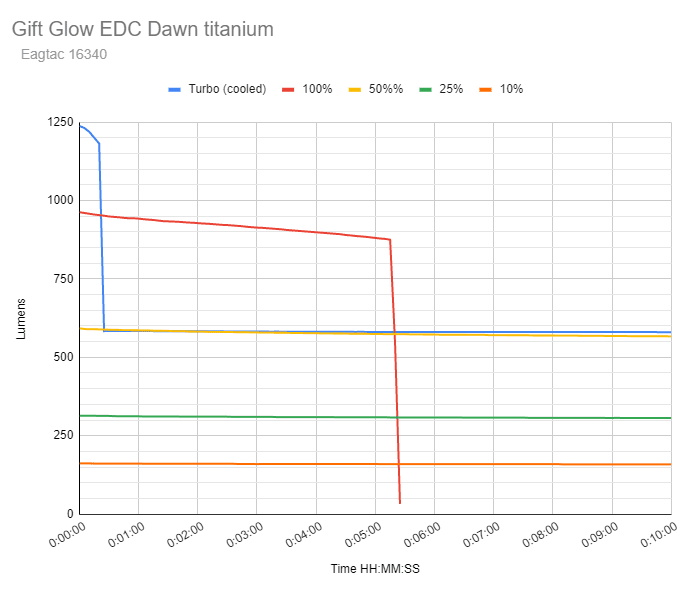
| Mode | Specified | Measured runtime (ANSI FL1) | Time till shut off |
|---|---|---|---|
| 1% | – | – | – |
| 10% | – | 2h06min | 3h51min+ |
| 25% | – | 1h12min | 1h40min+ |
| 50% | – | 24min | 1h38min+ |
| 100% | – | 05min | – |
| Turbo* | – | 17min | 18min+ |
*In Turbo and High mode, the light switches to AUX after several minutes…. So I pointed a fan at the light for the Turbo test. But Turbo also turned into AUX after 18 minutes.. and I stopped the test.
The battery was down between 2.68V to 2.8V after each runtime test. But after High it was still 3.8V when I turned it off (because it turned on in AUX mode)
ANSI FL1 standards: The runtime is measured until the light drops to 10% of its initial output (30 seconds after turn on). This does not mean that the flashlight is not usable anymore. The last column shows how long the light actually works till it shuts off. If there is a + symbol, it means that the test was stopped at that particular point, but the light was actually still running. This happens on certain occasions, with certain drivers, firmware, or batteries.
Throw Measurement: Peak beam intensity and beam distance
Measurements were taken indoors with a Hagner E4-X Lux Meter, at 5 meters. 30 seconds after turn on.
| Mode | Candela measured | Meters | Yards |
|---|---|---|---|
| 50% | 1,050 | 65 | 71 |
| 100% | 1,950 | 88 | 97 |
| Turbo | 1,950 cd | 88 | 97 |
| Turbo (turn on) | 3,925 cd | 125 | 137 |
Turbo dropped around 25 seconds after turn on, so it looks like Turbo and 100% are the same. However, at turn on, there is a clear difference between Turbo and 100%.
The UI overview is so messed up, that testing is very hard, because sometimes I test 1 mode twice, or write it down in the wrong spot, because the actual modes don’t match the UI graph.
Extra info: Peak beam distance according to ANSI FL1 standards: The calculated value of distance in meters at which the flashlight produce a light intensity of 0.25 lux. (0.25 lux is about the brightness of a full moon shining on an object).
Beamshots
For the following beamshots I used a Canon EOS 5D Mk2 and a 50mm lens. manual settings: ISO1600, 1/4sec , F4, 5000K
The shed is about 65 meters / 71 yards away.
Unfortunately, when I went out to do beamshots, I didn’t know there was a Turbo mode, and the 100% mode in Group 3 was also incorrect, because it actually is 50%. Well done! Not… Here are the beamshots.. Getting High or Turbo doesn’t make it better, because they drop very quickly, and aren’t very useful anyway.
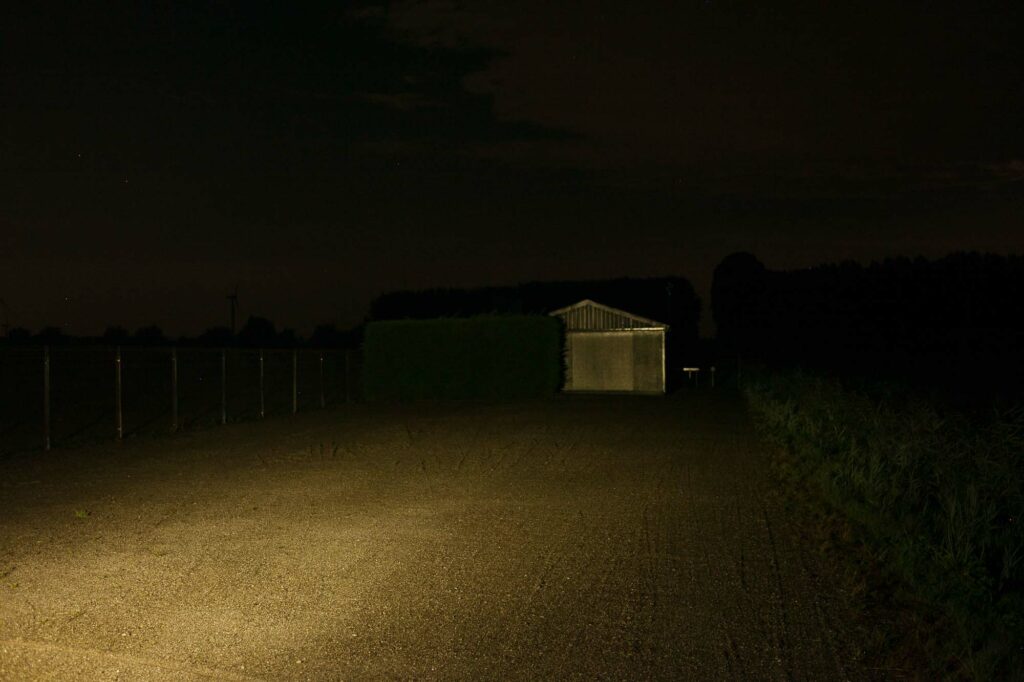
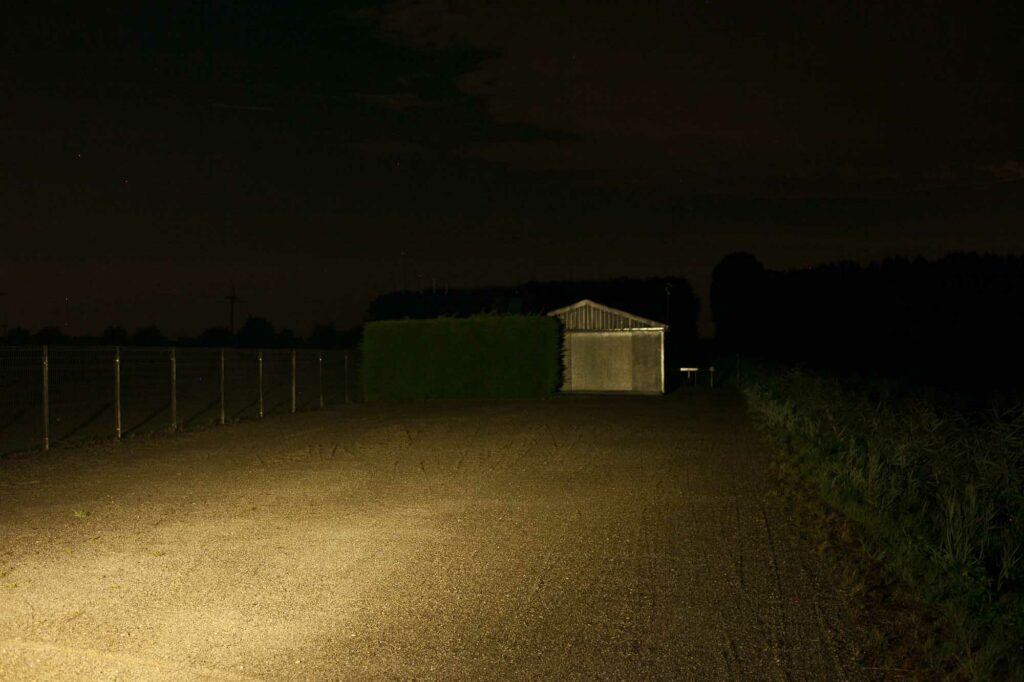
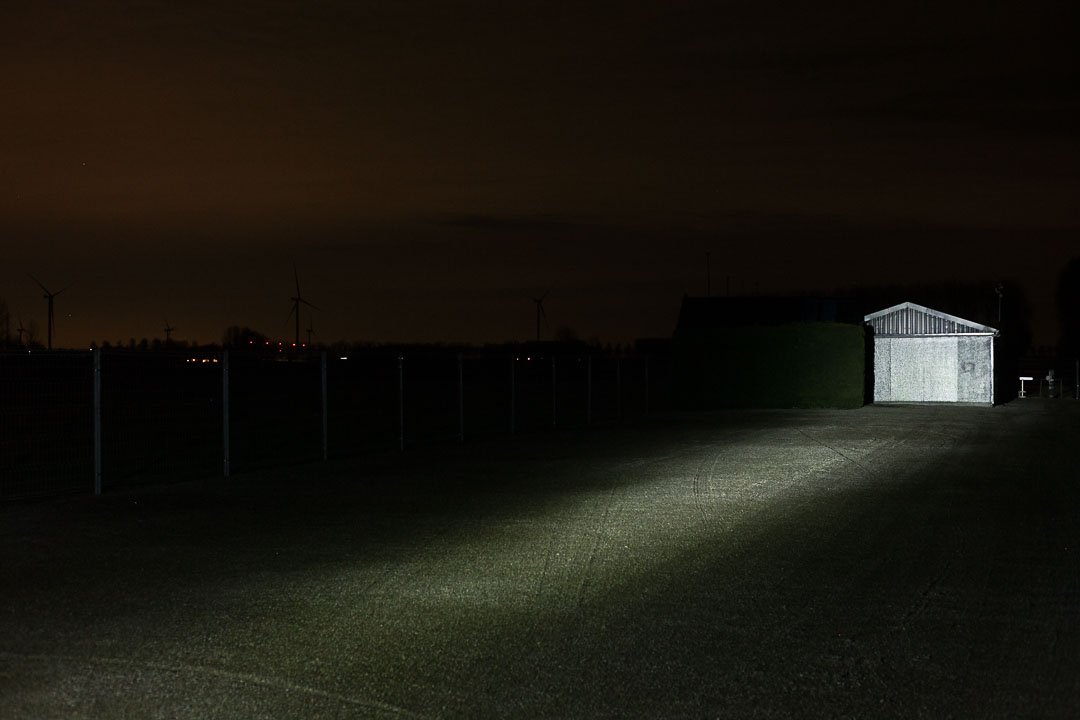
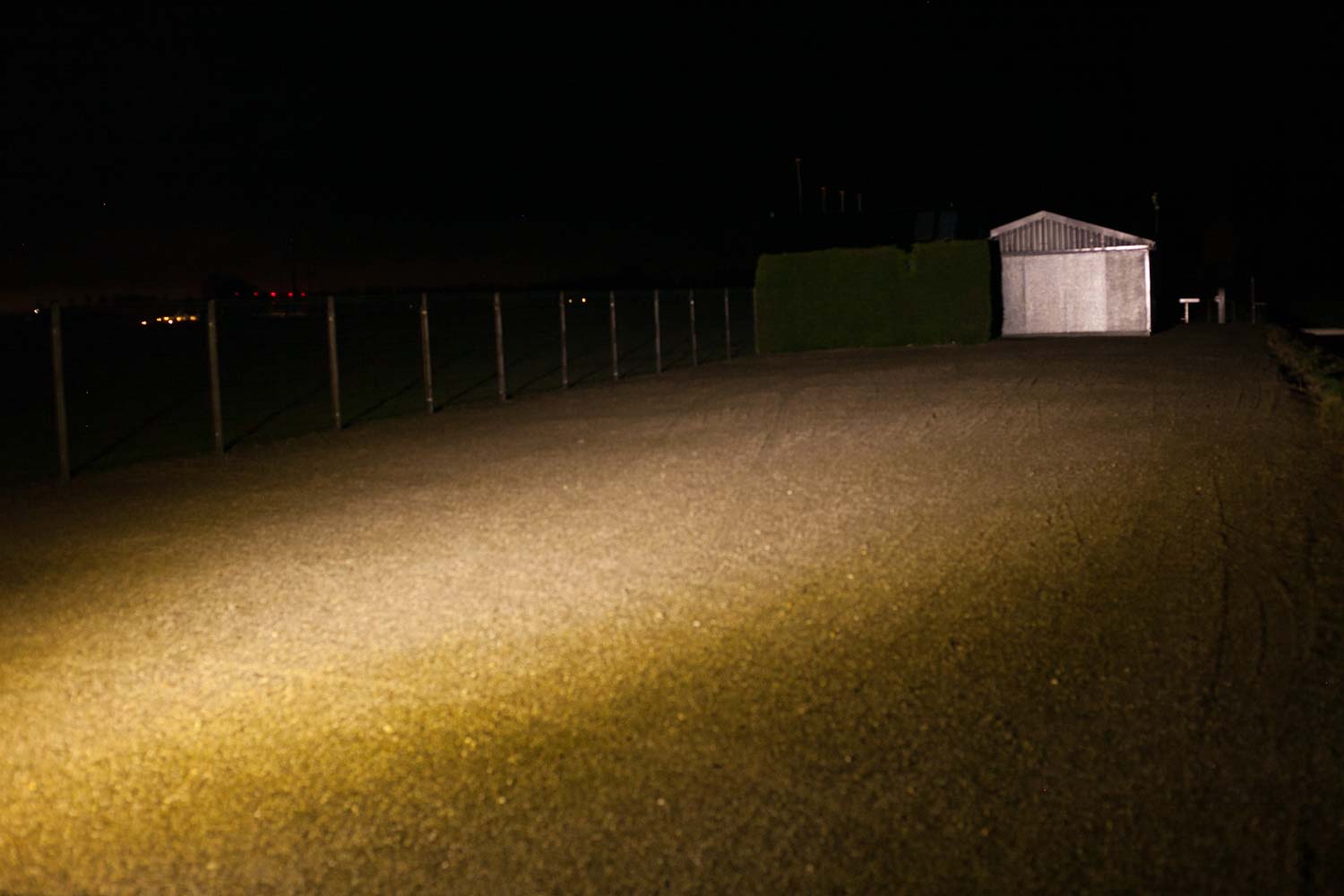
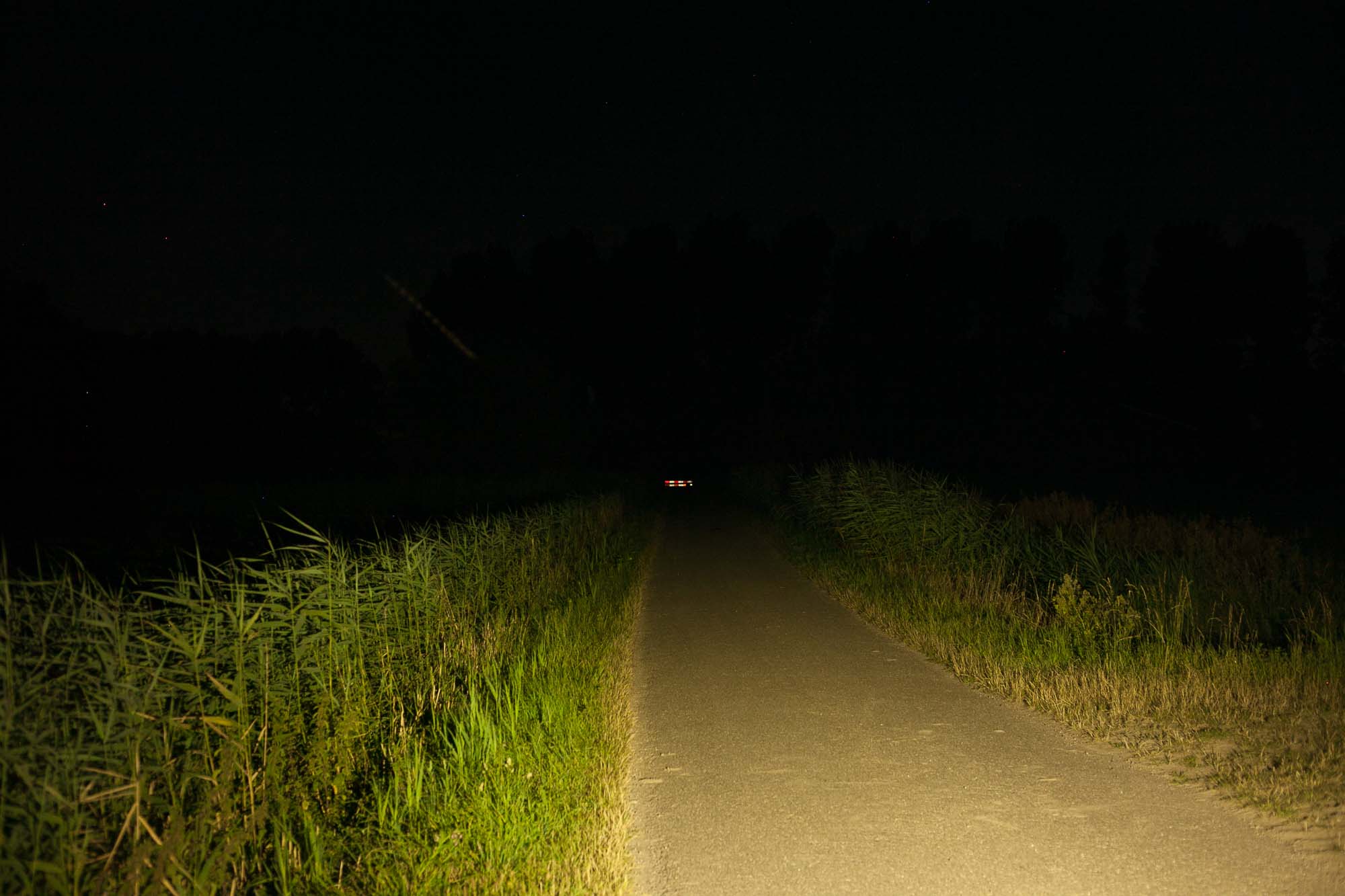

Disclaimer: This flashlight was sent to me for review at no cost by Nealsgadgets. I have not been paid to review, nor have I been holding back on problems or defects.
Final Verdict
Pros
- Fidget spinner, anyone?
- Lots of trit slots
- See-through design
- Titanium
- Unique design
Cons
- Very strange UI options (see the UI section)
- Needs a lot of practice to enter Menu configuration mode, or Mode-memory configuration mode.
- Bad performance in High and Turbo with Eagtac battery
Explanation on star ratings:
1: Avoid: my phone flashlight would be a better choice – 2: Poor: significant defect or issues; almost unusable – 3: Average: some defects or issues; but still usable 4: Good: recommended (minor issues) – 5: Great: highly recommended

3 stars: ★★★
All that glitters is not gold. And unfortunately, that also has to be said about the Gift Glow EDC Dawn. It looks very, very pretty, and I love the fidget spinner, but the UI and bad performance make it almost unusable for daily carry. It’s very hard to get into the Menu programming mode, and the included UI diagram is incorrect. Plus, the mode spacings aren’t well thought through. You could make it a great flashlight if you flash your own firmware, but I’m not sure how easy that is going to be.
Or, just set the mode group to something a bit usable (like group 4), and never touch anything else.
Gift Glow EDC Dawn discount code
Still interested? Use our unique coupon code: 1LumenNew or 1Lumen711
1lumen selects and reviews products personally. We may earn affiliate commissions through our links, which help support our testing.